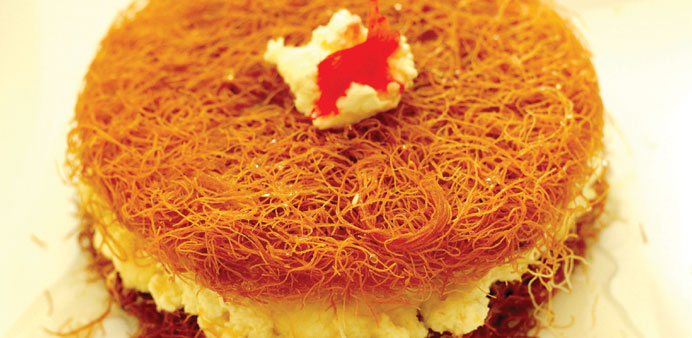Tarun Kapoor is executive chef at Doha’s Horizon Manor Hotel. Send your feedback to:
[email protected]
As we celebrate the holy month of Ramadan and break our fast every day after sunset one delicacy that everyone likes is the hot Kunafeh. I can definitely vouch that Iftar is not complete without Ramadan desserts and Ramadan desserts are not complete without the Kunafeh.
Kunafeh is the perfect dish to complete the Iftar. Kunafeh is an Arabic pastry made of spun wheat strands first baked and then soaked in sweet sugar-based syrup. The Kunafeh originated in the city of Nablus in Palestine but is famous now across the globe and specially Middle East for its great taste and texture.
There are numerous recipes and variants of this dessert. The city of Nablus in Palestine is especially renowned for its Kunafeh. The largest plate of Kunafeh was made in Nablus in an attempt to win a Palestinian citation in the Guinness World Records. It measured 75×2 metres and weighed 1,350 kilograms.
Palestinian cuisine has its own distinct features but shares many features and influences with food from other parts of the region, including desserts (there are many regional variations of Kunafeh including in Jordan, Syria, Lebanon and Turkey).
The story of Kunafeh begins when it was introduced by a physician who saw a princess having a hard time fasting because of her appetite. He created the dish and instructed the princess to eat a great amount of it just before dawn, and as a result she was never hungry during the day.
Kunafeh is a sweet dessert made from spun shredded wheat and topped with raisins, nuts, and cream. In different variations of this dish, the cream is replaced by mozzarella cheese or by cream cheese and at times also flavoured with cinnamon or rose water. Kunafeh is an Arabic pastry made with spun shredded wheat soaked in sugar syrup and topped with nuts, raisins and cream.
Like the traditional Nablus variant, Lebanese Bil Jibn Kunafeh and some more local variants using different ingredients.
Kunafeh pastry comes in three types based on the texture of the dough used in the making. First is the rough one in which the crust is made with long thin noodle threads of spun wheat. Second is the fine texture where the dough is made with semolina and the third and last one is the mixed one, which is made with a combination of the above two types of dough. My personal favourite is the second one.
In different variations of this dish, the cream is replaced by mozzarella or by cream cheese and at times cinnamon is added. This is one of my favourite desserts and my family loves it too, we’ve been relishing this sweet treat ever since I came to Qatar three years back.
Kunafeh
Serves 4
Ingredients
Kunafeh dough 400 gm
Desi ghee 200 gm
For filling
Akawi cheese 600 gm
Semolina ½ cup
Sugar syrup 2 tbsp
For sugar syrup
Sugar 500 gm
Water 500 gm
Rose water few drops
For Garnish
Pistachio 50 gm
Method
Grease a baking tray with ghee and spread a layer of half of Kunafeh dough.
Keep another baking tray on the dough and place a heavy weight on top to make the dough flat.
In the meanwhile slice the cheese and keep it dipped in cold water for 10 minutes to remove excess salt.
Repeat the above step till the cheese loses its salty taste (approximately 5- 6 times).
Layer this desalted cheese on the Kunafeh dough layer.
Add remaining Kunafeh dough on top of cheese and press again using another baking tray and heavy height.
Leave aside to set for 1 hour and remove the top tray and apply remaining desi ghee on top.
Bake in a pre-heated oven for 25 minutes at 220 degree Celsius.
Make a thick sugar syrup by boiling together sugar and water and adding rose water to flavour.
Once the top layer has a nice golden colour, remove from the oven and pour the prepared and cooled sugar syrup as desired,
Garnish with crushed pistachio and serve hot.

DESSERT: Kunafeh


